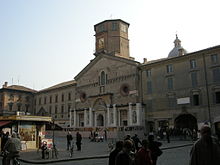Diocese of Reggio Emilia-Guastalla
|
Diocese of Reggio Emilia-Guastalla Dioecesis Placentina-Bobiensis |
|
|---|---|

Reggio Emilia Cathedral
|
|
| Location | |
| Country | Italy |
| Ecclesiastical province | Modena-Nonantola |
| Statistics | |
| Area | 2,394 km2 (924 sq mi) |
| Population - Total - Catholics |
(as of 2010) 569,853 504,133 (88.5%) |
| Parishes | 318 |
| Information | |
| Denomination | Catholic Church |
| Rite | Roman Rite |
| Established | 1st Century |
| Cathedral | Cattedrale di Beata Vergine Assunta (Reggio Emilia) |
| Co-cathedral | Concattedrale di Ss. Pietro e Paolo (Guastalla) |
| Current leadership | |
| Pope | Francis |
| Bishop | Massimo Camisasca, F.S.C.B. |
| Emeritus Bishops |
Adriano Caprioli Giovanni Paolo Gibertini, O.S.B. |
| Website | |
| reggioemilia.chiesacattolica.it | |
You may be looking for the archdiocese of Reggio Calabria-Bova
The Diocese of Reggio Emilia-Guastalla is a Roman Catholic ecclesiastical territory in Emilia-Romagna, Italy. It has existed in its current form since 1986. In that year the historical Diocese of Reggio Emilia was united with the Diocese of Guastalla. The diocese is a suffragan of the Archdiocese of Modena-Nonantola.
In the Capitulary of Quierzy, Reggio was included among the towns which Pepin had in mind for the Donation of Pepin, but it came into possession of the Papal States only later, and for a short time. After the death of Countess Matilda (1165) the popes claimed the town as a part of her inheritance, while the emperors claimed the same as a fief of the Holy Roman Empire.
Reggio accepted the vicars of Emperor Henry VII and Louis the Bavarian, and was subject to the pope under Cardinal Bertrand du Poyet (1322). Later (1331), John of Bohemia, who recognized the suzerainty of the pope over Reggio as well as over Parma and Modena, was made lord of the city, but sold it to the Fogliani, from whom it passed to the Gonzaga of Mantua (1335), who sold it to Galeazzo II Visconti of Milan. In 1409 it returned again to the House of Este of the line of Modena, until 1859. The popes, however, always claimed to be its suzerains. After the Ferrara War, Reggio spontaneously submitted to Pope Julius II (1512–15). By the Peace of Barcelona (1529), Emperor Charles V bound himself to give back Reggio to the popes, but he did not do so.
...
Wikipedia
